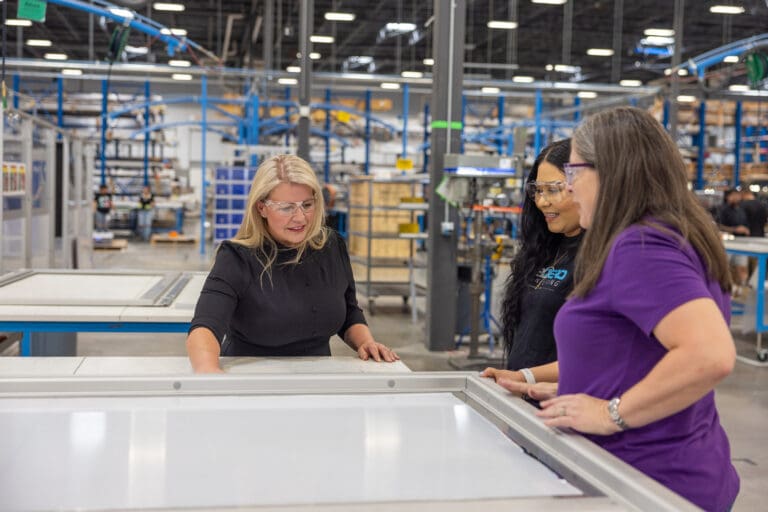“It will take 283 years before women make up an equal share of the tech workforce if the current trend continues.”

That’s the stark warning from the British Computer Society (BCS), the Chartered Institute for IT – and it’s one that should have the entire industry jumping to action.
It’s no secret that, in recent years, the technology industry hasn’t exactly been highlighted as a leading example when it comes to promoting and encouraging diversity and inclusion. While awareness of the issue and proactive measures to tackle it have increased, the fact remains that not enough has been done to close the apparent 300-year gender gap – and we have a long way to go. In today’s landscape especially, with AI and other key advancements playing a crucial role in our advancing digital era, the need for a skilled, passionate and – importantly – varied, in expertise and background, workforce couldn’t be more critical.
You're invited! Join SheCanCode's Women in Tech Community
Find a supportive network, opportunities, jobs & much more, so you can excel in your tech career.
Addressing the imbalance
To see material progress, current figures must first be made aware of the extent of the gender imbalance. Knowledge is power, and closing the gap will require focus and commitment from all corners of the industry. That starts with as many people as possible banging the drum around the benefits of tapping into what potentially untapped talent can bring.
The BCS Diversity Report stated that the number of female technology workers stalled in 2022, according to BCS analysis of ONS data. This is despite having grown from a share of 16 per cent to 20 per cent between 2018 and 2021.
In another clear indicator of the need for change, the same report highlighted that black women still only account for 0.7 per cent of specialists, despite increasing from 0.3 per cent in 2019.
Those numbers clearly do not correlate with a sector that is attracting and retaining workers from all walks of life at the rate that would allow it to fully prosper. Acceptance and awareness of the imbalance that exists is the first step to truly addressing it.
The importance of role models
Part of lessening the gender gap, and encouraging more women to achieve their ambitions, rests on increasing the number of role models visible to the next generation. This means ensuring that all levels within an organisation have strong and diverse representation leading the way, from board level down to graduates.
People need to see it to believe they can be it and, for many, climbing the career ladder becomes much easier when they can take inspiration from those who are already living their dream. It demonstrates that they, too, can make their mark and become a C-suite leader, an esteemed business representative or a trusted technical expert.
Particularly as technology has always been a male-dominated sector, having a role model or a mentor to seek guidance and counsel from can be invaluable when it comes to finding the self-belief needed to begin what can be a daunting path.
Flexible policies
A big part of levelling the playing field, and encouraging women to enter the industry to begin with, comes in embracing flexible working policies, which allow those with caring responsibilities, for example, to pursue their professional goals while meeting personal commitments.
Whether it’s implementing work from home and work from anywhere policies, or introducing options that increase support for those returning from maternity leave, flexibility can make a huge difference, helping women – and all staff – to find a positive work-life balance.
When it comes to returning from maternity leave, for example, some organisations operate a core hours model, which means the whole team has to be online from 10am to 3pm but the rest of the hours are flexible, allowing parents to manage childcare without added pressure.
Organisations must continue to provide optimal working environments to staff who are more dispersed than ever before. Ensuring growth opportunities are provided, despite location, as well as offering platforms for voices to be heard, are vital to motivation, satisfaction and company culture. It is those businesses that show a commitment to development by facilitating meaningful support and training, and encouraging differing personalities and approaches, that will reap the benefits.
Embracing a diverse talent pool
Embracing a diverse talent pool isn’t about trying to fill a quota, it’s about seeing and unlocking the advantages this can bring.
Utilising diverse backgrounds, life experiences, views and skills across levels and areas arms organisations with fresh perspectives, approaches and solutions.
When it comes to executive teams, McKinsey found that companies with the greatest female representation are 39 per cent more likely to financially outperform companies in the lowest quartile of female representation. This also extends to ethnic diversity, as organisations with greater representation also increase the likelihood of financial overperformance by 39 per cent versus the bottom quartile.
For those reasons, and many more, there is simply no excuse for not making diversity and inclusion, and all its facets, a priority.
It’s time for women to be bold
Technology is broad and far-reaching, so it’s important for each woman entering the industry to keep a clear perspective of what making it work looks like for them. Women, as with any employees, should be open, curious about new challenges, and proactive.
Females have so much to offer the technology industry and should feel able to vocalise what is needed for them to take up – and excel in – career pathways that have been laid down.
The sector has long been called upon to unleash the full suite of benefits that women can bring, both professionally and personally, and now is the time to leverage the tools available to show them what success could be and, ultimately, help them find their place.








